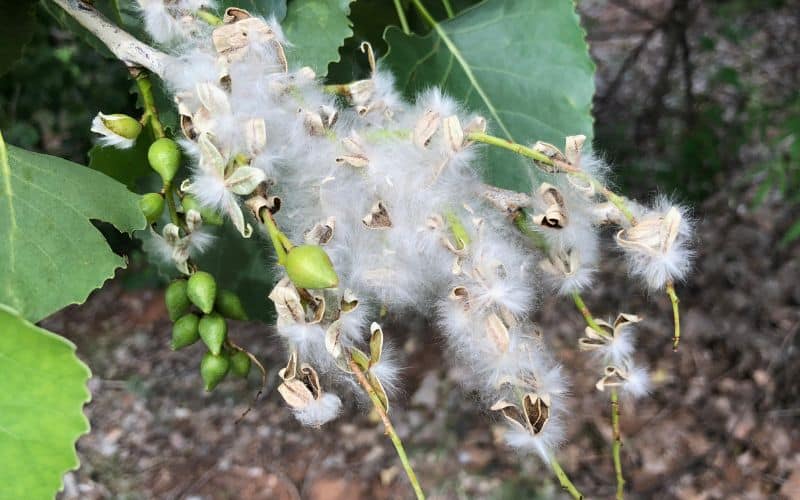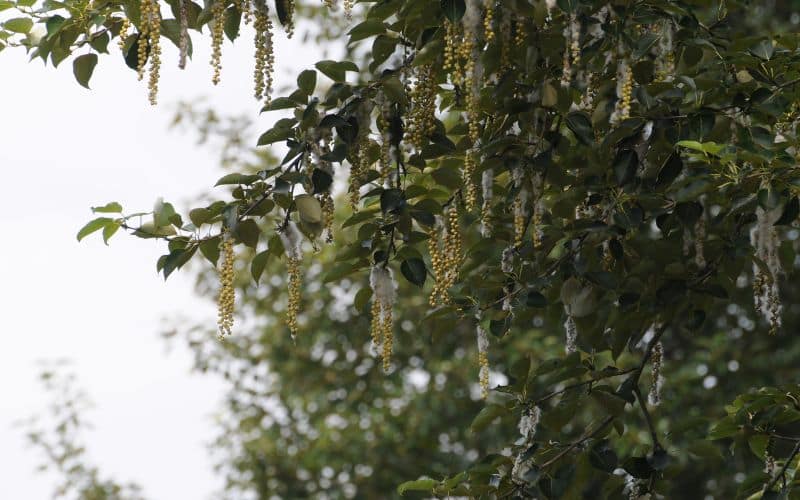
If you’re a lover of nature and particularly trees, then chances are you’ve encountered the majestic Eastern Cottonwood Tree. Native to Ontario, this unique tree species is an integral part of the province’s biodiversity. Its rapid growth and large size make it a remarkable sight in any landscape.
The Eastern Cottonwood Tree is botanically known as Populus deltoides. What sets it apart from other trees? Well, for starters, its distinctive triangular leaves that flutter beautifully in the breeze. It also boasts an impressive height; mature trees can reach up to 30 metres or more!
As if that’s not enough reason to appreciate these beauties, they’re also environmentally beneficial. With their ability to absorb pollutants from both air and water sources, they serve as vital components in maintaining our ecosystem’s health.
Understanding the Eastern Cottonwood Tree
Let’s dive right into the world of Eastern Cottonwood Trees. They’re native to Ontario and are known for their incredible size, often reaching up to 30 metres tall or even more! It’s this impressive stature that makes them a favourite amongst homeowners seeking shade and landscape appeal.
Now you might be wondering what these trees look like. Well, they have thick trunks that can span over 1 metre in diameter with greyish-brown bark. Their leaves are triangular shaped with curved teeth along the edges which turn yellow come autumn. And let’s not forget about those fluffy white seeds; it’s these cotton-like clusters that give the tree its name.
You’ll find them growing predominantly near water sources such as riverbanks or floodplains because they love moisture-rich soils. Despite this preference for wetter environments, don’t be fooled into thinking they’re delicate – quite contrary actually! These trees boast a fast growth rate and strong resilience against disease, pests and varying weather conditions.
Interestingly enough, while most people know them for their aesthetic appeal or use in timber production (their wood is light yet durable), there’s more than meets the eye here:
- Their barks were traditionally used by indigenous communities for medicinal purposes.
- As one of North America’s largest hardwoods species, it plays an important role in ecosystems by providing shelter to wildlife.
- Its roots help stabilise soil erosion along waterfronts.
So next time you spot an Eastern Cottonwood tree standing tall against Ontario’s skyline – remember there is much more going on beneath those leafy branches than just beauty alone!
The Habitat and Distribution of Eastern Cottonwood in Ontario
If you’ve ever wondered about the Eastern Cottonwood tree, you’re not alone. It’s a fascinating species that thrives in certain areas of Ontario. Let’s delve into its habitat and distribution to understand why it favours these specific regions.
To begin with, Eastern Cottonwoods love water. You’ll often find them near rivers, lakes or wetlands as they require a lot of moisture to grow properly. They also appreciate well-drained soil conditions but don’t be fooled – they’re pretty hardy trees and can adapt to different types of soils if need be.
In terms of geographical spread across Ontario, there’s quite an interesting pattern at play here:
- Northern Regions: The presence is relatively low due to the harsher climate.
- Southern Regions: They are more common because conditions are more favourable.
- Western parts: Here too their numbers are significant due to the presence of many river systems.
A closer look reveals how the Eastern Cottonwoods have adapted themselves according to various ecological factors prevalent in these regions:
| Region | Factors |
|---|---|
| Northern | Harsh Climate |
| Southern | Favourable Conditions |
| Western | Presence Of River Systems |
This doesn’t mean you won’t spot an occasional cottonwood gracing other parts of Ontario though! These hardy trees do manage surprising feats when it comes down to survival.

Identifying Characteristics of the Eastern Cottonwood Tree
Dive headfirst into the world of Ontario’s native flora, specifically one tree that stands out from the crowd – The Eastern Cottonwood. It’s a remarkable specimen, identifiable by its unique characteristics which we’ll delve into now.
Firstly, it’s all about size with this tree. Standing tall and proud, an adult Eastern Cottonwood can reach impressive heights between 20 to 45 metres. That’s not something you’d easily miss in your local woodland! Its trunk diameter is no less imposing either – usually measuring around 1 metre when matured.
Look up at its branches and you’re likely to spot a thick canopy adorned with glossy green leaves during spring and summer months. Come autumn though, these turn yellow creating a striking contrast against other trees’ multi-coloured foliage.
Now take note of its bark – quite distinctive in nature too! On young trees it’s smooth and greenish-yellow but as they age it becomes deeply furrowed with long flat ridges – somewhat resembling popcorn on close inspection!
Finally remember to check for cottony seeds blowing in late spring or early summer wind; after all that’s how our beloved eastern cottonwoods got their name!
- Height: Between 20-45m
- Trunk Diameter: Approx.1m (in mature specimens)
- Leaves: Glossy Green (Spring & Summer), Yellow (Autumn)
- Bark: Smooth & Greenish-Yellow on Young Trees; Deep Furrows & Flat Ridges on Mature Ones
- Seeds Appearance: White fluff known as ‘cotton’
Remember these identifiers next time you’re exploring Ontario’s forests or parks – they’ll certainly help pinpointing an Eastern Cottonwood amongst Canada’s vast array of indigenous trees.
Importance and Uses of Ontario’s Eastern Cottonwood
Ontario’s Eastern Cottonwood is more than just a towering spectacle. It’s an integral part of the region’s ecosystem, offering numerous benefits that are often overlooked.
One critical aspect is its role in environmental stability. You’ll find these trees acting as windbreaks due to their rapid growth and sturdy nature. They’re also excellent at soil erosion control, helping maintain the health and balance of Ontario’s landscapes.
Next on the list is their value for wildlife habitats. Birds such as owls, woodpeckers, and eagles often choose cottonwoods for nesting sites due to their height and thick foliage coverage. The tree’s fluff or ‘cotton’ provides essential material for nest building too!
But it doesn’t stop there! These trees have economic importance as well:
- Their fast-growing nature makes them perfect for timber production.
- The soft yet durable wood is used in making pallets, crates or even furniture.
- Bark extracts are utilised in various pharmaceutical products due to medicinal properties.
Finally let’s not forget about carbon sequestration – another crucial benefit provided by these giants! One large eastern cottonwood can absorb around 22kg of carbon per year which significantly contributes towards reducing greenhouse gas emissions.
So next time you see an Eastern Cottonwood standing tall amongst Ontario’s diverse flora – remember it isn’t just there looking pretty! It serves multiple purposes from environmental conservation right through to commercial uses – truly embodying a green giant with immense value.

Conclusion: The Value of the Eastern Cottonwood in Ontario
You’ve journeyed with us through the life and importance of the Eastern Cottonwood tree in Ontario. By now, you’ll appreciate its ecological significance, cultural heritage, and economic value.
The Eastern Cottonwood’s ecological contributions are vast. It plays a vital role in providing habitat for many wildlife species. From insects to mammals like beavers – all find refuge amidst its branches or within its bark crevices. You’d also be surprised at how much these trees contribute to improving our air quality!
Economically speaking, it’s not just about timber production either; your local farmers love this tree! They make good use of it as a windbreak to protect crops from harsh winds while beekeepers relish their early bloom for honey production.
Historically and culturally speaking, indigenous communities have valued the cottonwood for centuries – using every part from leaves to roots in various ways. Today that tradition continues with contemporary artists finding inspiration within this tree’s character-filled woodgrain.
It’s clear then why we must conserve these beautiful giants:
- Ecological value: Habitat provider and air purifier
- Economic contribution: Timber supply chain player and farming aid
- Cultural significance: Indigenous tool resource and artist muse
Let’s remember that preserving our natural heritage isn’t just about what nature gives us but also what we give back. So next time you stroll by an Eastern Cottonwood remember – you’re witnessing a living testament to Ontario’s rich biodiversity! In protecting them today we ensure they continue enriching our lives tomorrow.








